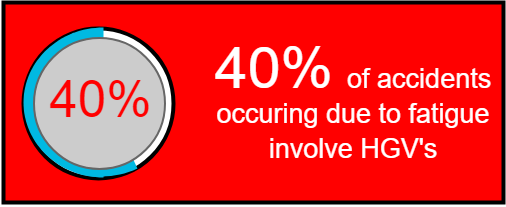Why do the Drivers Hours laws exist?
To prevent tiredness among HGV drivers.
It's the first thing we're taught in Periodic CPC. In Module 1, in fact.
So, how effective are those laws? Do they do the job?
Or perhaps they're too strict, or maybe not strict enough...
Much is said about the Big Stats:
- Fatigue plays a role in 20% of all road traffic accidents,

- It contributes to 25% of fatal and serious accidents, and
- 40% of said incidents involve an HGV.
So what's the crack? Why implement and enforce this complicated set of rules, even when it fails to prevent the hazards associated with HGV driver fatigue?
As usual in this line of work, it ain't that simple. Drivers hours laws must utilize the findings of neuroscience; a field in which facts are continuously debated, rejected, revised and denounced. It's a difficult task, marrying legislation to science. Especially a subject as murky as the human brain.
It's a widely misunderstood topic. In every profession involved, from drivers, TMs and operators to government officials and even the scientists themselves, there's a struggle to get the collective noggin around it.

As a result, there are a few myths kicking around. So, for a special Easter treat, I've decided to dispel a few. Only 3 though, it ain't Christmas.
1. 'Fatigue' means asleep - at least in the eyes of the fuzz
When investigating an accident, police will only consider fatigue a factor if it's obvious the driver was asleep. Evidence of this includes failing to brake, or veering from lane to lane.
This avoids the problem of how fatigued is fatigued. For example, the heavily-fatigued brain is capable of a thing called 'local sleep'. This means sleep occurs only in the area which controls memory, language and judgement - the frontal lobe. Local sleep doesn't affect motor skills - so under its influence, a driver could appear to drive normally; contrary to the idea that tiredness necessarily means loss of control. They would, however, probably miss signs, turns, and on-road incidents.
2. The 15-minute break has little (if any) benefit
One of the commonest questions in Drivers' Hours classes is: why is the 45-minute break broken down the way it is?
It's a valid question. Especially since there's absolutely no evidence that a break of 15 minutes has any discernible impact on the worn-out brain.
Studies show, however, that breaks of 30 minutes and over do have a positive effect. It stands to reason, then, that more flexibility towards drivers' breaks could be of huge benefit to those of us behind the V8. After all, energy levels and performance under fatigue vary from person to person. As we consider this more and more, the Cast-Iron Rule for All makes less and less sense.
3. Abiding by the rules isn't enough
I know - you've got to deliver this load at such and such a place, then turn tail and pick up another load by such and such time - we've all got a lot to do, and not much time to do it. But the truth is: drivers hours laws are not the be-and-and-end-all. A driver must look out for themselves, and know their own limits.
The TC's office recently told Commercial Motor that the rules exist 'as a limit, not a target' and that 'Most...operators consider that complying with the drivers' hours rules is all that is needed to manage the risk from fatigue'.
It's a pain, I get it. Here we must work by these complicated, heavily-enforced laws, and they're not even enough to keep us safe.
But as any regular of our little blog will know, we're all about the individual drivers keeping it real. Looking out for yourself is the name of the game - and no law can regulate against that.
If, like me, the drivers' hours laws do your head in, there's another way you can tackle it. Get yourself onto an online course. They're short, sweet and loaded with content. Or don't. I mean, it is Easter after all.
But if you're interested:





